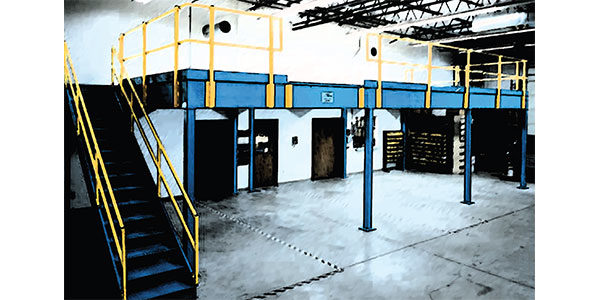A higher calling

It's a common enough dilemma these days. Say you're a retailer looking to add an online sales channel to your operations. You have several options. You can build a new facility to handle your e-commerce distribution, you can build onto an existing facility, or you can outsource the task to a third party.
But there's another option—one that's often overlooked: You can look up. No, we're not talking about seeking heavenly guidance, though that's not a bad idea before starting any major project. We're talking about making use of the facility's vertical space.
Building up—as opposed to out—allows a company to gain more operating space without altering a building's footprint, which is especially important to facilities that are landlocked. It's also significantly cheaper than building out or constructing a stand-alone facility.
"It allows you to get the best utilization of square footage and density. You don't want to build more of a building footprint than you need," says Rick Herlacher, manager of the solutions development team at Dematic, a systems manufacturer and integrator.
As for how to make use of a facility's vertical space, there are a couple of options. One is to build a mezzanine; the other is to install a work platform.
Of the two, adding a mezzanine tends to be more complicated process. A mezzanine, which typically runs from wall to wall, is essentially another story that's built between two others in a building. Because they're generally considered permanent fixtures, mezzanines must meet codes for sprinklers, egress, lighting, accessibility by the disabled, and so on.
Installing a work platform is a much simpler matter. Work platforms are typically freestanding steel structures that are not mounted to the walls or hung from the ceiling. Instead, they derive their support from the building's floor and their own columns.
From a construction perspective, work platforms offer a number of advantages over mezzanines. To begin with, they're generally considered equipment, rather than permanent fixtures, which means they're likely exempt from the codes that apply to mezzanines. On top of that, their status as equipment means they can be depreciated faster than a building structure.
They're also easy to reconfigure as needs change, so they offer a high degree of flexibility. Plus, they're readily customizable. "Most work platforms are customer specific and are engineered around a particular space or particular need," says Arlin Keck, an engineer at storage equipment maker Steel King who serves as chair of the engineering committee for the Storage Manufacturers Association within MHI.
WHY GO UP?
Building up—as opposed to out—offers a number of advantages to companies expanding into new channels like e-commerce, say those in the know. For one thing, installing a mezzanine or platform will enable them to move into the new channel faster, since they don't have to deal with the delays associated with site searches and construction.
"If a company wants to enter the e-commerce world, then the sooner they are up and running, the better. It takes a long time to build something new," says Klaus-Dieter Wurm, vice president and managing director for SSI Schaefer, a systems manufacturer and integrator.
"The key advantage is timing," adds Todd Brendel, the head of engineering and structural solutions for Wynright, a material handling equipment supplier and integrator. With work platforms, he says, "the design process is straightforward and very clean. While the time in new construction is quite long, [a work platform] can just bolt together like a kit." Brendel adds that a typical work platform can be installed within about six weeks.
There are inventory-related benefits as well. For one thing, locating fulfillment operations for different channels at a single facility allows those channels to share inventory. This can lead to faster inventory turns and reduces the amount of money a company must tie up in stock. "It allows companies to leverage that inventory rather than duplicate it," says Chris Arnold, vice president of operations and solutions development for Intelligrated, a company that manufactures and integrates systems.
The shared inventory can also allow for better use of existing material handling resources. For instance, the same sorter that handles store orders may be utilized for e-commerce orders, depending on order profiles.
Other advantages include control and flexibility. Housing fulfillment operations for multiple channels in the same building enables companies to react more swiftly to problems. Labor can be diverted easily from one channel's processing area to another as needed. And speaking of labor, there's no need to train an additional workforce as there might be when separate facilities are used. You can simply utilize the same staff.
ROOM AT THE TOP
One of the questions often asked when it comes to work platforms is what applications they're best suited for. According to the experts, the field is pretty much wide open. Work platforms can accommodate picking operations, sorting systems, fast-response processing, slow-moving inventory, value-added services, and more. Depending on the application, work platforms can be staffed by employees or simply used to house equipment. They can also hold conveyors that feed larger systems, such as automated storage and retrieval systems, although some work platforms are built simply to keep conveyors off the facility floor so that lift trucks can cross underneath.
"Conveyors are a natural fit, but slower movers can also go there. It's a matter of how it fits into the entire operation of a facility," says Tripp Eskridge, senior vice president of project and development services for industrial real estate developer Jones Lang LaSalle.
Companies looking to get the most out of their DC space may want to consider using their work platforms for highly automated functions. Dense storage units, such as vertical lift modules, shuttle systems, and carousels, allow large quantities of goods to be held in a minimal amount of space. Platforms are also good for housing workstations, such as picking or packing areas for order fulfillment. Goods-to-person stations can also find a home on work platforms.
Work platforms can also be a good solution for seasonal operations, either to handle certain products seasonally or to accommodate overflow volumes during peak periods. (And if you're looking to add a work platform, off-season is a good time for the installation, since there is less stress on the facility.)
When considering whether to add a work platform to an existing building, it's important to make sure the concrete floor can support the weight of the platform and its load. This is especially true if the platform is intended to hold heavy, dense storage or automated equipment. Floors can usually be reinforced if found to be lacking.
Also, consider what role the platform will play now and in the future. If future uses cannot be easily determined, then it's better to design a work platform that can support more weight than you need now than to have to retrofit and reconfigure later. Because of the way they're constructed, work platforms can also be relocated within the facility or to another building if needed down the road.
"That makes them good for current needs as well as for the future," notes Schaefer's Wurm.
Related Articles

Copyright ©2024. All Rights ReservedDesign, CMS, Hosting & Web Development :: ePublishing